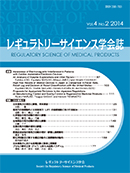Volume 12, Issue 1
Displaying 1-13 of 13 articles from this issue
- |<
- <
- 1
- >
- >|
-
2022Volume 12Issue 1 Pages 1-2
Published: 2022
Released on J-STAGE: January 31, 2022
Download PDF (174K)
-
2022Volume 12Issue 1 Pages 3-15
Published: 2022
Released on J-STAGE: January 31, 2022
Download PDF (391K)
-
2022Volume 12Issue 1 Pages 17-24
Published: 2022
Released on J-STAGE: January 31, 2022
Download PDF (343K)
-
2022Volume 12Issue 1 Pages 25-36
Published: 2022
Released on J-STAGE: January 31, 2022
Download PDF (477K)
-
2022Volume 12Issue 1 Pages 37-43
Published: 2022
Released on J-STAGE: January 31, 2022
Download PDF (348K) -
2022Volume 12Issue 1 Pages 45-53
Published: 2022
Released on J-STAGE: January 31, 2022
Download PDF (683K) -
2022Volume 12Issue 1 Pages 55-62
Published: 2022
Released on J-STAGE: January 31, 2022
Download PDF (340K) -
2022Volume 12Issue 1 Pages 63-73
Published: 2022
Released on J-STAGE: January 31, 2022
Download PDF (560K) -
2022Volume 12Issue 1 Pages 75-83
Published: 2022
Released on J-STAGE: January 31, 2022
Download PDF (339K) -
2022Volume 12Issue 1 Pages 85-92
Published: 2022
Released on J-STAGE: January 31, 2022
Download PDF (397K) -
2022Volume 12Issue 1 Pages 93-97
Published: 2022
Released on J-STAGE: January 31, 2022
Download PDF (257K)
-
2022Volume 12Issue 1 Pages 99-105
Published: 2022
Released on J-STAGE: January 31, 2022
Download PDF (583K)
-
2022Volume 12Issue 1 Pages 107
Published: 2022
Released on J-STAGE: January 31, 2022
Download PDF (274K)
- |<
- <
- 1
- >
- >|
